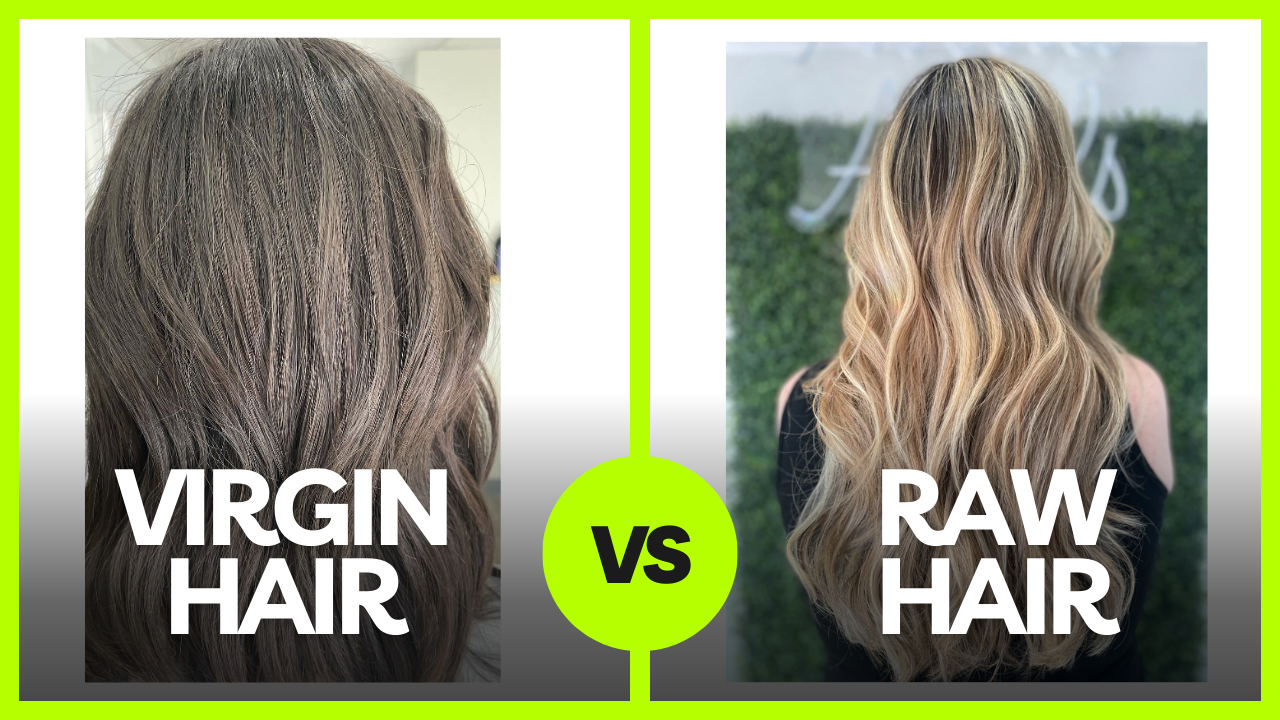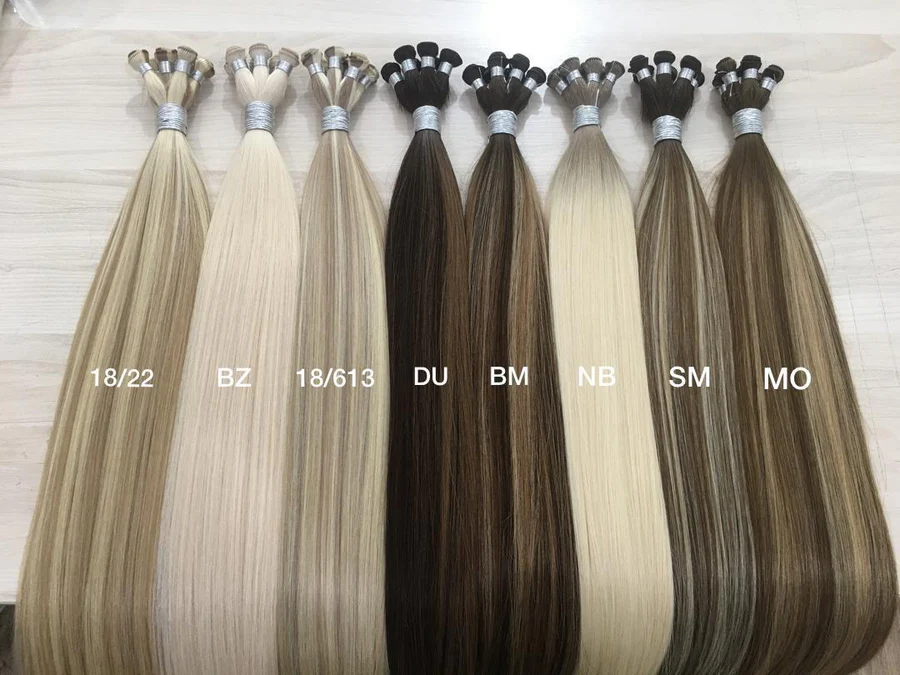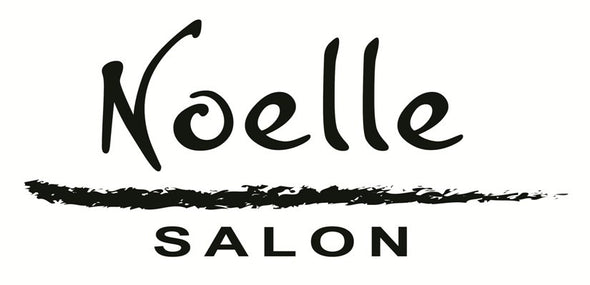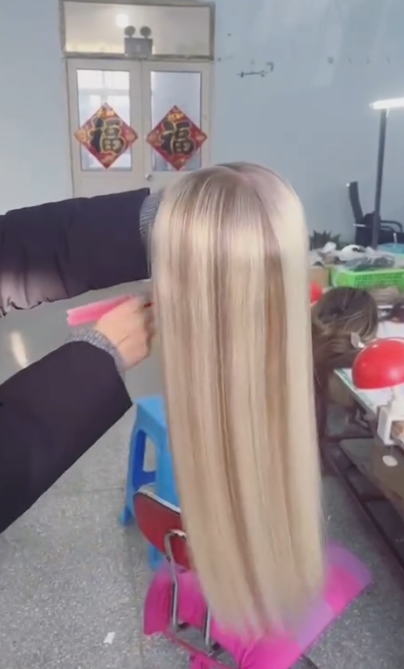Raw Hair vs Virgin Hair: Your Complete Guide

Raw Hair vs Virgin Hair: Which is Best for Your Style?

Ever feel lost choosing between raw hair and virgin hair? You’re not alone! With so many terms floating around—unprocessed hair, true virgin hair, raw virgin hair—it can get confusing real quick. Whether you're eyeing straight hair or a specific hair texture, understanding the difference matters.
Let’s clear up the confusion around raw hair vs virgin hair—because let’s be real, the terms can sound pretty similar, right? But trust us, there is a difference, and knowing it makes all the difference when choosing your perfect bundle.
What Raw Hair Really Is and Why It Matters?

So, what is raw hair exactly? It’s 100% natural human hair that hasn’t been through any chemical processing. No color, no curls, no heat styling. It’s literally cut straight from the donor's head, with all the cuticles intact, making it the purest form of hair you can get. That’s why many say it’s the gold standard for extensions.
Now, here’s where it gets interesting: once that raw hair is chemically altered in any way—even just to add waves or change the color—it’s no longer considered “raw.”
So, if you’re wondering what the difference is between raw and virgin hair, or need help deciding which is better—raw or virgin hair, here’s the scoop: raw hair is the most untouched, natural form. It usually comes in straight or natural wavy textures; every bundle is unique since it’s sourced from a single donor.
But keep in mind—virgin vs raw hair isn’t just about being natural. Health matters too. Just because hair is raw doesn’t always mean it’s in top shape. Some raw bundles might come from donors with UV-damaged or poorly cared-for hair. So, always look for healthy raw hair, not just raw by label.
Busting Raw Hair Myths
There are a lot of misconceptions surrounding raw hair, especially with so many different types of human hair extensions available on the market. Don't worry if you've been wondering what’s true or false; we’ve got you covered! Let’s dive into a few of the most common misunderstandings and set the record straight.
Misconception 1: All Raw Hair Equals Great Quality
Fact: Just because hair is labeled as "raw" doesn’t automatically mean it's the highest quality. The quality of the hair depends on the source and the donor's hair health. Raw hair can come from various places, including China, India, or Vietnam, and each donor’s hair might be in a different condition. It’s important to check if the hair has been well cared for and maintained to ensure you're getting the purest form of virgin hair that will last.
Misconception 2: Raw Hair Comes in All Types of Textures
Fact: Raw hair material typically comes in its natural, unprocessed state—mainly straight hair or slightly wavy textures. If you're seeing raw hair that's been chemically manipulated to create curly hair or other available hair textures, it's no longer technically raw. These altered textures strip the hair of its "raw" status and may affect its elasticity. If you’re after a specific hair style, it’s always best to choose hair that hasn’t been processed.
Misconception 3: Raw Hair Doesn’t Need Maintenance
Fact: Raw hair is the purest form of virgin hair, but that doesn’t mean it’s low-maintenance. Like your natural hair, raw hair extensions need regular care and attention to keep them looking their best. This includes gentle washing, conditioning, and minimizing heat styling to maintain that full cuticle hair structure. Neglecting your raw hair could lead to tangling, loss of shine, and deterioration of quality over time.
So, whether you're shopping for raw virgin hair or considering types of human hair extensions, remember that each bundle's quality, care, and unique appearance matter more than just the label! Always be sure to choose carefully and maintain your hair with the same love and attention you give your own. Happy styling!
Why Virgin Hair is the Purest Choice for Your Perfect Locks?
Virgin hair is human hair that hasn't been chemically processed. However, it might have been styled with heat or steam to achieve a particular texture. The key point here is that the cuticles remain intact and are aligned in the same direction, ensuring a natural, smooth look. Virgin hair is often considered a top-tier option, comparable to raw hair. Still, it’s important to note that some variations exist in the market depending on how much the hair has been manipulated.
Understanding the True Meaning of Virgin Hair
Virgin hair is all about purity—it’s not altered with chemicals, and typically, it maintains its natural state. But here's where things can get a bit tricky. Different vendors might have slightly different interpretations of what counts as "virgin hair." For example, some might include steam-styled hair as virgin hair, which doesn't significantly impact the quality or durability of the hair.
However, there’s a little confusion when it comes to curly textures. To achieve curls, manufacturers often steam the hair, and while the hair might still be cuticle-aligned, the process can alter the cuticles, leading to potential tangling. That’s why sometimes cuticles are removed to prevent this issue.
Comparing Raw Hair vs Virgin Hair: Which One's Right for You?
When it comes to picking the right hair extensions, understanding the difference between virgin and raw hair can make all the difference! Let’s break it down so you can easily tell which type is best for you.
1. The Purity Factor
-
Raw Hair: Raw hair is the purest form of hair you can get. It's 100% unprocessed, meaning it hasn’t been treated with any chemicals, dyes, or steam. The hair is collected from a single donor and retains all the natural cuticles intact.
-
Virgin Hair: Virgin hair, on the other hand, is also high-quality and unprocessed, but it can undergo minimal styling with heat or steam. It’s still natural but might have been lightly manipulated to create specific textures like curls or waves.
2. Texture and Look
-
Raw Hair: This type of hair comes straight from a single donor and remains untouched, so each bundle's texture is natural and unique. Raw hair typically has a straight or slightly wavy pattern, though sometimes it can have a little curl. The key here is its authenticity—since it’s not manipulated in any way, the texture you get is purely from the donor’s hair.
-
Virgin Hair: When it comes to raw hair vs virgin hair, virgin hair is a bit more versatile. It’s still unprocessed, but it can be steamed or styled with heat to create a variety of textures. You’ll find everything from sleek straight strands to loose waves and even tight curls. Virgin hair offers more options for those who like to switch up their look regularly.
3. Cuticle Alignment
-
Raw Hair: One of the standout features of raw hair is that the cuticles are all aligned in the same direction, which helps reduce tangling. This gives it a smooth, natural look and feel.
-
Virgin Hair: Virgin hair typically also has cuticle alignment, but depending on how the hair was styled or steamed, the cuticles might not be as perfectly aligned as in raw hair.
4. Source of Hair
-
Raw Hair: Raw hair is usually collected directly from a single donor, which ensures that it is in its most natural form. However, it can sometimes come from different regions, like China, India, or Vietnam, each with its unique texture and characteristics.
-
Virgin Hair: Virgin hair can come from multiple donors, and while it still maintains high quality, the texture might slightly vary based on the source and how it was processed before reaching you.
5. Price Point
-
Raw Hair: Because raw hair is unprocessed and comes directly from the donor, it’s typically more expensive. The quality is unbeatable, but you’ll pay a premium for its purity.
-
Virgin Hair: Virgin hair is still high-quality, but since it’s more widely available and can be steamed or heat-styled, it is usually more affordable than raw hair.
6. Maintenance and Longevity
-
Raw Hair: The beauty of raw hair is that it can last a long time, anywhere from 2 to 5 years or more, depending on how well it’s cared for. Since it's unprocessed, you'll need to treat it like your natural hair: wash it regularly, condition it, and moisturize it to ensure it stays shiny and healthy.
-
Virgin Hair: Virgin hair lasts a good while too, typically about 1 to 2 years, but it doesn’t quite match the lifespan of raw hair. Because of the heat or steam treatments used to create different textures, virgin hair might need a bit more maintenance to keep it looking fresh. Still, it’ll hold up for quite a while with the right care.
Factors to Consider Before Buying: Raw Hair vs Virgin Hair
Before you jump into buying raw hair vs virgin hair, here are a few things you should keep in mind:
1. Cost vs Value
One of the main differences between raw hair vs virgin hair is cost. If you want to get the most out of your investment, raw hair often has a higher price tag due to its untouched nature and superior longevity. But it’s worth considering how much wear and tear your hair extensions will face. Raw hair’s durability may save you money in the long run, since it can last several years when properly maintained.
On the other hand, virgin hair is typically a bit more affordable. If you're looking for something that fits your budget while still providing great quality and flexibility in terms of texture, virgin hair is a solid choice.
2. Styling Flexibility
Another point to consider when deciding between raw hair and virgin hair is styling flexibility. While raw hair has a natural look and feel, its styling options can be a bit limited because it's mostly left in its natural state. You can certainly style it, but it won’t hold as many intricate shapes as virgin hair, especially if you're looking for defined curls or more structured waves.
Virgin hair, however, offers a much wider range of possibilities. Since it's often heat-treated or steamed to create specific textures, it responds well to various styles, whether you’re going for sleek and straight or bouncy curls.
3. Personal Hair Goals
Do you love to experiment with different looks, or do you prefer a more consistent, natural style? If you’re in the raw hair vs virgin hair debate, knowing your hair goals will help you choose.
If you desire a more natural, minimalistic approach with the option to style it occasionally, raw hair might be for you. It’s the purest form of human hair, perfect for someone who values authenticity and longevity.
However, virgin hair is ideal if you're after versatility and styling freedom. Whether you're into dramatic curls, waves, or sleek styles, virgin hair offers more variety without compromising quality.
4. Authenticity and Quality
Choosing high-quality hair is important, whether you go for raw hair vs virgin hair.
-
Authenticity: Always buy from reputable sellers who clearly describe their hair’s origins. Make sure you're getting genuine raw hair or virgin hair, as some sellers may misrepresent their products with buzzwords like ‘Brazilian’ or ‘Remy.’ These terms can sometimes be used inaccurately, so do your research!
-
Quality: The quality of raw hair vs virgin hair is largely determined by how it's sourced and processed. High-quality hair should feel natural, with no chemical smell or synthetic fibers mixed in. Be wary of deals that seem too good to be true—cheap prices often come with compromised quality.
How to Identify High-Quality Hair Extensions
Whether you’re buying raw hair vs virgin hair, quality is key. Here’s what to look for:
-
Smell: Your hair should never have a chemical or strange smell. A fresh, natural scent is what you should expect from high-quality hair.
-
Texture: High-quality hair should feel soft and natural. It might not be the real deal if it's too silky or dull.
-
No Shedding or Tangling: A good sign of quality is that the hair doesn’t shed or tangle easily. This means the cuticles are intact and aligned, preventing friction.
-
Heat and Dye Responsiveness: Virgin hair vs raw hair should react well to both heat and color treatments. But raw hair, with its pure nature, usually responds better and holds styles longer.
-
No Fillers: High-quality hair should not contain fillers or synthetic materials. Be sure the hair is 100% natural, without any animal hair or artificial fibers mixed in.
When deciding between raw hair vs virgin hair, it all comes down to your personal preferences. Think about the texture, maintenance, and budget that work best for you. And always be sure to buy from a trusted seller to ensure you get the real deal!
Virgin vs Raw Hair: Find Your Perfect Match at NoelleSalon.com!
Choosing between raw and virgin hair doesn’t have to be tricky, especially when you have a trusted place to shop! If you're looking for top-notch hair extensions that suit your style and needs, NoelleSalon is the place to be. Whether you want the pure, unprocessed goodness of raw hair or the versatility of virgin hair, they’ve got you covered with premium options that feel just as fabulous as they look.
Hop over to Noelle Salon to check out their amazing collection of hair extensions. No matter your preferred texture, color, or style, they’ll help you find the perfect match. And with their expertise, you can be sure you’re getting the highest quality hair for that flawless look!
Visit NoelleSalon now and elevate your hair game today!
Conclusion
Choosing between raw and virgin hair doesn’t have to be complicated! With the right info, you can easily pick the one that fits your style, maintenance habits, and budget. Raw hair gives you pure authenticity and long-lasting quality, while virgin hair offers a wider variety of textures and styles.
Whether you're after natural waves, silky curls, or a sturdy body wave for endless styling, understanding these key differences will make your hair shopping experience easy and stress-free. Ultimately, it’s all about what suits you best, helping you feel confident and fabulous daily!
Frequently Asked Questions
What is the expected lifespan of Raw Hair and Virgin Hair?
With proper care, raw hair extensions can last 2 to 5 years, while virgin hair extensions usually last 1-2 years. The longevity of both largely depends on the maintenance and care they receive.
How can one test the quality of hair before purchase?
The quality of hair can be evaluated through its smell, texture, response to styling tools, and lack of shedding or tangling. Additional testing methods include acetone tests to rule out dyed hair and bleach tests to assess the hair's resilience to damage.
Are there specific care routines for each hair type?
Both raw and virgin hair require careful maintenance. Regular washing, conditioning, minimizing heat or chemical treatments, and using suitable hair products based on the texture are imperative to maintain the health and lustre of these extensions.
Can raw or virgin hair be colored or heat-styled?
Yes! Both raw hair vs virgin hair can be dyed or heat-styled, as they are human hair extensions. To maintain the health of these extensions post-processing, be sure to use quality products and follow a suitable hair care routine.
What are common marketing tricks to watch out for when buying hair extensions?
Avoid labels like 'Brazilian hair' or 'Remy hair' without proper product descriptions. Other tricks include misleading price tags, inaccurate bundle weights, and ambiguous specs about processing methods. Make sure to validate the vendor's credibility through customer reviews and detailed product information.
Which is better, raw or virgin hair?
Choosing between raw and virgin hair depends on your preferences. Raw hair offers the highest purity and longevity, perfect for those seeking authenticity and minimal manipulation. Virgin hair, on the other hand, provides more texture options and versatility while maintaining high quality. It ultimately depends on your styling and maintenance needs.



